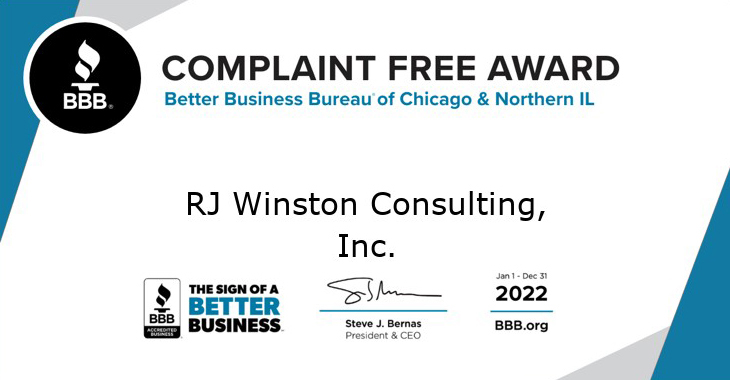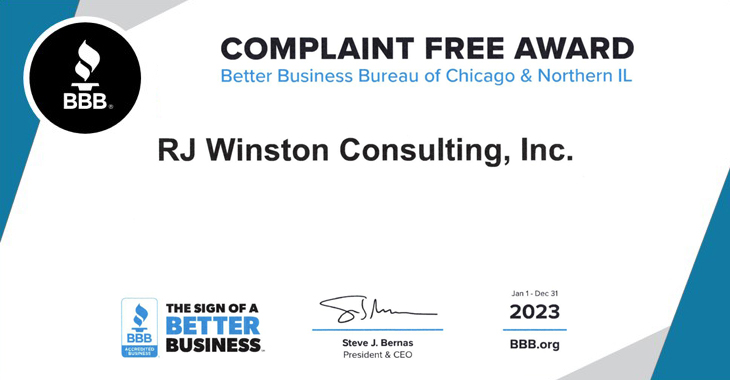



RJ Winston Consulting ADA Accessibility Statement
ADA ACCESSIBILITY on RJWinston.com: RJWinston.com makes available the UserWay Website ADA Accessibility Widget that is powered by a dedicated accessibility server. The software allows RJWinston.com to improve its compliance with the Web Content Accessibility Guidelines (WCAG 2.1).
GENERAL: RJ Winston Consulting Inc. strives to provide ADA Accessibility to all individuals to ensure that its services are accessible to people with disabilities. RJ Winston Consulting Inc. has invested a significant amount of resources to help ensure that its website is made easier to use and more accessible for people with disabilities, with the strong belief that every person has the right to live with dignity, equality, comfort and independence.
ENABLING the ADA ACCESSIBILITY MENU: The RJWinston.com ADA Accessibility menu can be enabled either by hitting the tab key when the page first loads or by clicking the ADA accessibility menu icon that appears on the corner of the page. After triggering the ADA Accessibility menu, please wait a moment for the accessibility menu to load in its entirety.
DISCLAIMER: RJ Winston Consulting Inc. continues its efforts to constantly improve the ADA Accessibility of its site and services in the belief that it is our collective moral obligation to allow seamless, accessible and unhindered use also for those of us with disabilities. In an ongoing effort to continually improve and remediate ADA Accessibility issues, we also regularly scan RJWinston.com with UserWay’s ADA Accessibility Scanner to identify and fix every possible accessibility barrier on our site.
Despite our efforts to make all pages and content on RJWinston.com fully accessible, some content may not have yet been fully adapted to the strictest ADA Accessibility standards. This may be a result of not having found or identified the most appropriate technological solution.
HERE FOR YOU: If you are experiencing difficulty with any ADA Accessibility content on RJWinston.com or require assistance with any part of our site, please contact us during normal business hours as detailed below and we will be happy to assist.
CONTACT US: If you wish to report an ADA Accessibility issue, have any questions or need assistance, please contact RJ Winston Consulting Inc.
CUSTOMER SERVICE CONTACT INFO:
Email: [email protected]
Phone: Phone: +1 (708) 227-1254

About ADA Accessibility Compliance
(Source: ADA.gov – U.S. Department of Justice & Civil Rights Division)
The Americans with Disabilities Act (ADA) protects people with disabilities from discrimination. Disability rights are civil rights. From voting to parking, the ADA is a law that protects people with disabilities in many areas of public life.
Introduction to the Americans with Disabilities Act
The Americans with Disabilities Act (ADA) is a federal civil rights law that prohibits discrimination against people with disabilities in everyday activities. The ADA prohibits discrimination on the basis of disability just as other civil rights laws prohibit discrimination on the basis of race, color, sex, national origin, age, and religion.
The ADA guarantees that people with disabilities have the same opportunities as everyone else to enjoy employment opportunities, purchase goods and services, and participate in state and local government programs.
The ADA Protects People with Disabilities
A person with a disability is someone who:
- has a physical or mental impairment that substantially limits one or more major life activities,
- has a history or record of such an impairment (such as cancer that is in remission), or
- is perceived by others as having such an impairment (such as a person who has scars from a severe burn).
If a person falls into any of these categories, the ADA protects them. Because the ADA is a law, and not a benefit program, you do not need to apply for coverage.
Examples of Disabilities
There is a wide variety of disabilities, and the ADA regulations do not list all of them. Some disabilities are visible and some are not. Some examples of disabilities include:
- Cancer
- Diabetes
- Post-traumatic stress disorder
- HIV
- Autism
- Cerebral palsy
- Deafness or hearing loss
- Blindness or low vision
- Epilepsy
- Mobility disabilities such as those requiring the use of a wheelchair, walker, or cane
- Intellectual disabilities
- Major depressive disorder
- Traumatic brain injury
The ADA covers many other disabilities not listed here.
The ADA Prohibits Disability Discrimination in Many Areas of Life
To prevent discrimination against people with disabilities, the ADA sets out requirements that apply to many of the situations you encounter in everyday life. Employers, state and local governments, businesses that are open to the public, commercial facilities, transportation providers, and telecommunication companies all have to follow the requirements of the ADA.
The ADA prohibits discrimination based on disability.
Under the ADA, it is illegal to discriminate against someone because of their disability.
For example, a fitness center could not exclude a person who uses a wheelchair from a workout class because they cannot do all of the exercises in the same way.
However, a local rec center might only be open to people who live in the surrounding zip code. If the rec center refused access to a person with epilepsy because that person lived in a different zip code, that would not be a violation of the ADA because the rec center would not be discriminating on the basis of the person’s disability.
The ADA is broken up into five different sections, which are called titles. Different titles set out the requirements for different kinds of organizations. For example, Title I of the ADA covers requirements for employers, and Title II covers requirements for state and local governments. You can find the relevant title of the ADA noted next to each type of organization below.
Communicating Effectively with People with Disabilities: Communicating successfully is essential to providing services to the public or doing business. People with certain disabilities might communicate in different ways. State/local governments, businesses, and nonprofit organizations must make sure they communicate effectively with people who have communication disabilities.
Fact Sheet: Notice of Proposed Rulemaking on Accessibility of Web Information and Services of State and Local Government Entities
The Department of Justice (Department) is publishing a Notice of Proposed Rulemaking (NPRM) explaining how we propose updating the regulations for Title II of the Americans with Disabilities Act (ADA) to add more specific requirements about web and mobile application (app) accessibility.
This NPRM proposes a specific technical standard that state and local governments would have to follow to meet their existing obligations under Title II of the ADA for web and mobile app accessibility. The NPRM asks the public for comments about this proposal.
What is Title II of the Americans with Disabilities Act (ADA)?
Under Title II of the ADA, state and local governments’ services, programs, and activities must be accessible to people with disabilities. In Title II, state and local governments are also called public entities. Title II applies to all programs, services, or activities of state and local governments, from adoption services to zoning regulation. This includes the services, programs, and activities that state and local governments offer online and through mobile apps.
What is a Notice of Proposed Rulemaking (NPRM)?
Rulemaking is the process that federal agencies use to write regulations. A regulation (also called a “rule”) is a set of requirements issued by a federal agency to implement laws passed by Congress. When Congress passes laws, many details are often left to federal agencies to flesh out in regulations. For example, when Congress passed the ADA, it gave the Department the authority to issue regulations that explain the rights and obligations under Titles II and III of the ADA.
An NPRM is a stage in the rulemaking process that happens before an agency adopts a final regulation. It is like a first draft of a regulation. It lets the public know what the agency is considering and provides an opportunity for feedback.
An NPRM is not a final regulation. So, this proposal is not an enforceable rule right now. This NPRM has been published so that the public can provide us with feedback on our proposal for the rule before we adopt a final rule.
Who would be covered by this proposed rule?
Everyone that has obligations under Title II of the ADA would be covered by the proposed rule. Title II of the ADA applies to all public entities, including state and local governments, and departments, agencies, special purpose districts, special district governments, and other instrumentalities of state or local government.
Title II and the NPRM use the term public entities or state and local government entities to describe who they apply to, but in this fact sheet, we call these state and local governments. State and local governments that contract with other entities to provide public services (like non-profit organizations that run drug treatment programs on behalf of a state agency) also have an obligation to ensure that their contractors follow Title II.
Like the rest of Title II, the proposed rule would apply to all state and local government entities. Examples of these include:
State and local government offices that provide benefits and/or social services, like food assistance, health insurance, or employment services:
- Public schools, community colleges, and public universities
- State and local police departments
- State and local courts
- State and local elections offices
- Public hospitals and public healthcare clinics
- Public parks and recreation programs
- Public libraries
- Public transit agencies
Reasons for this Proposed Rule
State and local governments provide many of their services, programs, and activities through websites and mobile applications (apps). When these websites and mobile apps are not accessible, they can create barriers for people with disabilities.
This can also make it more difficult or impossible for people with disabilities to readily access important government services like absentee ballots or tax information that are quickly and easily available to other voters and taxpayers online.
Sometimes, inaccessible websites and mobile apps can keep people with disabilities from joining civic or other community events like town meetings or programs at their child’s school, or make it harder for them to join.
This proposed rule is intended to help better ensure access for people with disabilities and provide state and local governments with more clarity on how they can make sure they are complying with the ADA.
You can find more information about why the Department of Justice is proposing this rule in the NPRM in the section called “Need for Department Action.”
Highlights of the Proposals in the NPRM
Some of the specific proposed requirements found in the NPRM are highlighted below. Review the full NPRM to get an understanding of the entire proposal.
Proposal: Adopt the Web Content Accessibility Guidelines (WCAG) Version 2.1, Level AA as the technical standard that state and local governments would need to follow.
A technical standard says specifically what is required for something to be accessible. For example, the existing ADA Standards for Accessible Design are technical standards that say what is needed for a building to be physically accessible under the ADA. For instance, the ADA Standards for Accessible Design say how wide a door has to be or how steep a ramp can be.
WCAG, the Web Content Accessibility Guidelines, is a set of guidelines for web accessibility developed by the World Wide Web Consortium.
The NPRM proposes WCAG Version 2.1, Level AA as the technical standard for web content and mobile apps that state and local governments would be required to follow.
You can find more information about why the Department of Justice is proposing WCAG Version 2.1, Level AA as the technical standard in the NPRM in the sections called “Proposed WCAG Version” and “Proposed WCAG Conformance Level.”
Proposal: State and local governments’ web content and mobile apps would have to comply with the technical standard.
The proposed rule would apply to web content that a state or local government makes available to the public or uses to offer services, programs, and activities to the public.
What is web content?
The proposed rule would also apply to mobile apps that a state or local government makes available to the public or uses to offer services, programs, and activities to the public.
Example: If a local government lets people pay for its parking using a mobile app, the mobile app the local government uses would have to comply with the technical standard.
What is a mobile app?
Mobile apps are software applications that are downloaded and designed to run on mobile devices such as smartphones and tablets. You can find more information about how the Department proposes to address mobile apps in the NPRM in the sections called “Use of Mobile Applications by Title II Entities” and “Mobile Applications.”



